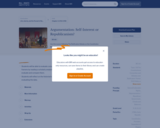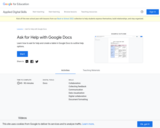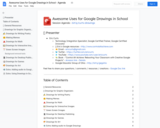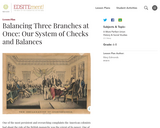
Use this Lesson following The Ratification Debate on the Constitution Narrative.
- Subject:
- Social Science
- Social Studies
- Material Type:
- Lesson Plan
- Provider:
- Bill of Rights Institute
- Date Added:
- 09/12/2022

Use this Lesson following The Ratification Debate on the Constitution Narrative.

Use this lesson after reading The Constitutional Convention Narrative and/or the Constitutional Convention Lesson.

An art gallery is holding a special exhibition of small watercolors. The exhibition will be held in a rectangular room that is 22 meters long and 20 meters wide with entrance and exit doors each 2 meters wide as shown below. Two security cameras are fixed in corners of the room, with the resulting video being watched by an attendant from a remote control room. The security cameras give at any instant a "scan beam" of 30o. They rotate backwards and forwards over the field of vision, taking 20 seconds to complete one cycle.

This resource from the National Constitution Center includes an introduction, big questions, recorded class sessions, briefing documents, slide decks, and worksheets about Article I of the United States Constitutuion.

This resource from the National Constitution Center includes an introduction, big questions, recorded class sessions, briefing documents, slide decks, and worksheets about Article II of the United States Constitutuion.

This resource from the National Constitution Center includes an introduction, big questions, recorded class sessions, briefing documents, slide decks, and worksheets about Article III of the United States Constitutuion.

This resource from the National Constitution Center includes an introduction, big questions, recorded class sessions, briefing documents, slide decks, and worksheets about Article V of the United States Constitutuion.

This resource from the National Constitution Center includes an introduction, big questions, recorded class sessions, briefing documents, slide decks, and worksheets about Article VII of the United States Constitutuion.

In 1777, the Second Continental Congress adopted the Articles of Confederation. The objectives of this activity are: Students will analyze the provisions of the Articles of Confederation. Students will determine why individuals such as George Washington expressed a growing concern over government’s inadequacies, and why these concerns were expressed by and heightened after events such as Shays’s Rebellion. Students will explain why there was a growing call for creating a strong central government and the rationales for the various arguments.

The number of artificial intelligence (AI) tools has grown significantly over the past few years. Some of the most popular tools are capable of creating seemingly original content, like images or text. Help students consider the ethical dilemmas of using AI to create content, and help them identify the appropriate use of these tools in a school setting.

In this Google Applied Digital Skills lesson, students will learn how to use Google Docs to ask for help.

Try out Search Coach and Domains when researching Astronaut food.

It is estimated that more than 30,000 Sudanese boys were orphaned or separated from their homes and families by the civil war that tore apart South Sudan between 1984 and 2005. Atem Aleu, from the Dinka tribe, was seven years old when his village was attacked. When Atem, out in the fields tending the cows with the other Dinka village boys heard the gunshots, they fled and began the one thousand mile walk, barefoot from Sudan to Ethiopia and finally to the Kenyan refugee camp in Kakuma. The survivors of this tragic escape became known as the ‘Lost Boys of Sudan.’

Share some great Google Drawing practices with your students through this amazing post from Control Alt Achieve.

Check out My World Global Curriculum series that illuminates global challenges and inspiring stories impacting today's youth.

My World Media Literacy, developed in partnership by BBC Learning, BBC World Services, and Microsoft, is a free educational platform for students ages 11-14 designed with the goal of increasing global media literacy and the evaluation of information presented in modern journalism. Featuring ten 45-minute lesson plans, each with activities and a companion video, these 21st century resources increase students’ critical thinking skills needed to be responsible consumers of news while inspiring them to become citizen journalists in order to navigate the news and form their own opinions.

Learn about the checks and balances system of the three branches of the U.S. government.

Students will take inspiration from the choreographer Charles Moulton and his community based ball passing choreography. Students will learn basic ball passing movements and rhythms and create their own way of ball passing with their friends.

The First National Bank has just been robbed (the position of the bank on the map is marked). The clerk pressed the silent alarm to the police station. The police immediately sent out police cars to establish road blocks at the major street junctions leading out of town. Additionally, 2 police cars were dispatched to the bank.

|The bank manager is trying to improve customer satisfaction by offering better service. Management wants the average customer to wait less than 2 minutes for service and the average length of the queue (length of the waiting line) to be 2 persons or fewer. The bank estimates it serves about 150 customers per day. The existing arrival and service times are given in the tables below